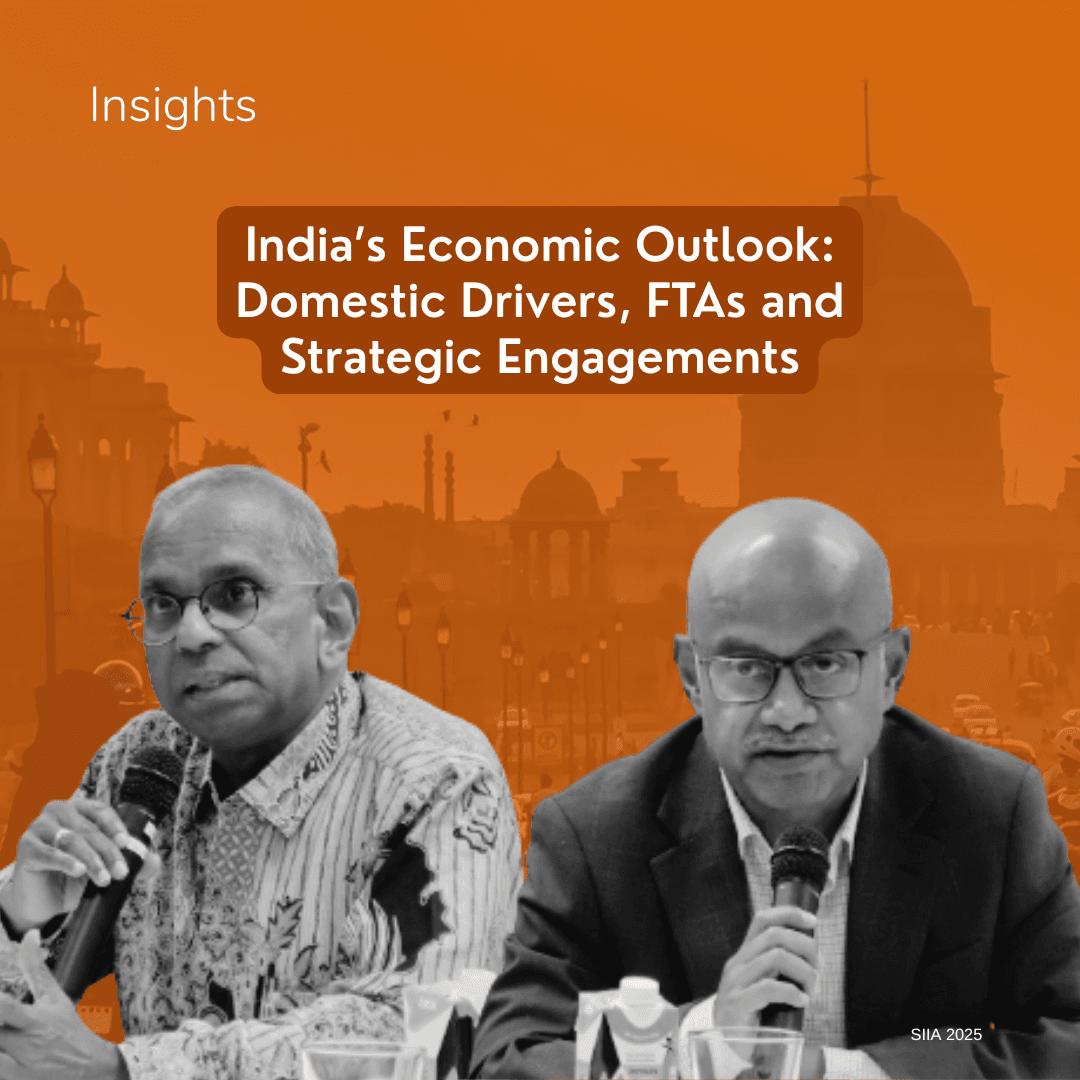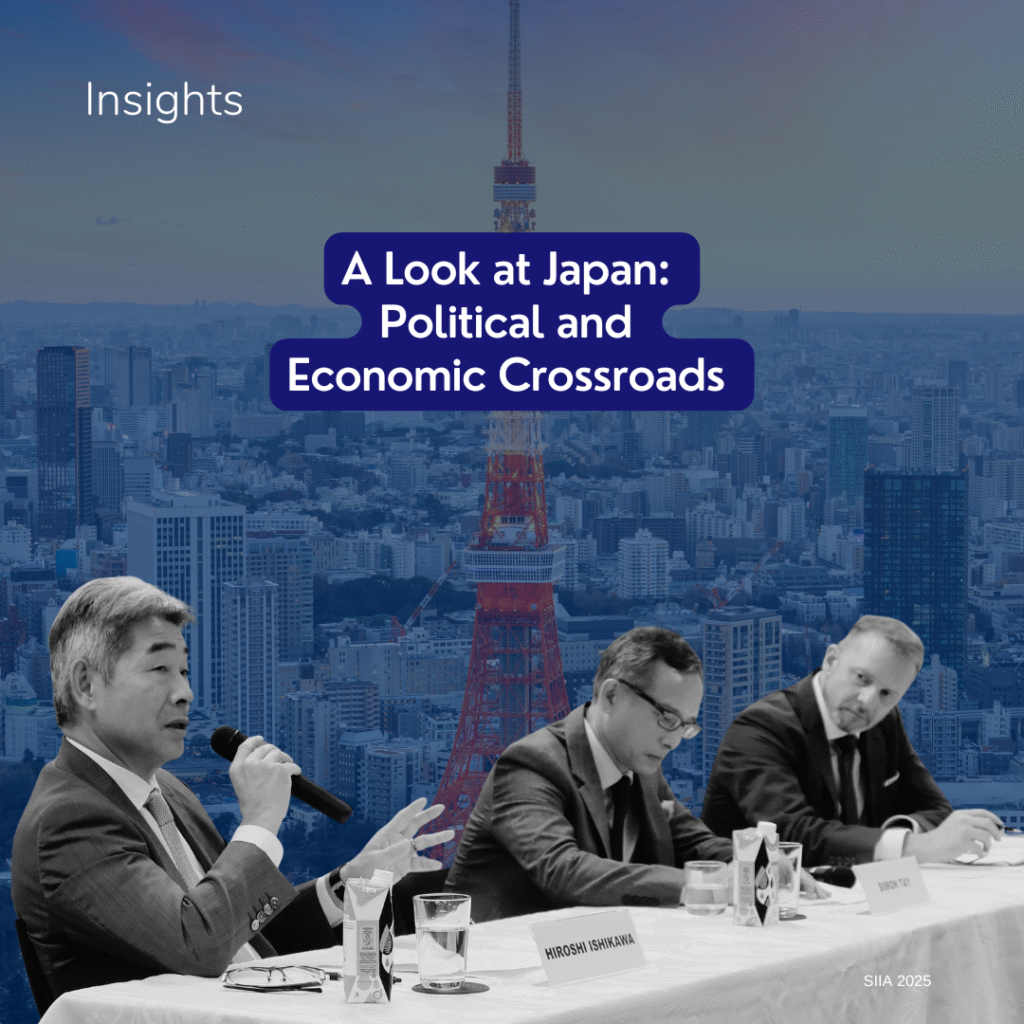India’s GDP is growing rapidly, supported by strong public investment and domestic consumption, positioning it to become the world’s third-largest economy by the end of the decade. However, sustaining this growth will require addressing ongoing challenges, such as investment slowdowns and geopolitical shifts. These various topics were explored at the “India’s Economic Outlook: Domestic Drivers, FTAs and Strategic Engagements” panel discussion organised by the Singapore Institute of International Affairs (SIIA) and The Institute of South Asian Studies (ISAS), National University of Singapore, on 20th August 2025.
The discussion featured insights from Mr. Manu Bhaskaran, Founding Partner & CEO of Centennial Asia Advisors; and Council Member at SIIA, and Dr. Amitendu Palit, Senior Research Fellow and Research Lead (Trade and Economics) at ISAS. The session was moderated by SIIA’s Chairman, Associate Prof Simon Tay.
Key Takeaways
India’s economic outlook
Mr. Bhaskaran shared a positive outlook on India’s near-term economic growth, noting that the negative impacts of Trump’s tariffs could be cushioned by productive agricultural yields from the recent monsoon season, growing consumer spending and interest-rate cutting by the Reserve Bank of India. In addition, Dr. Palit highlighted that India’s key services exports to the US remain untouched by tariffs. Against this backdrop, India is projected to achieve fiscal growth of 6.2% by March 2026.
Looking ahead, India could sustain long-term growth by leveraging its young workforce to capture production chains shifting away from China. This expansion would require an “ecosystem” of better labour laws and stronger infrastructure to boost India’s underperforming manufacturing sector.
India’s economic roadmap
On India’s shifting trade strategy, Dr. Palit highlighted the country’s economically protectionist stance, mainly driven by domestic lobbying efforts and the importance to protect vulnerable sectors.
He highlighted India’s strategy of export diversification, as a way to align domestic priorities with external commitments, such as with its Free Trade Agreements (FTAs) with big economies like the US, UK, and EU. Dr. Palit also weighed the potential of a Sino-India FTA. India and China have shared longstanding trade relations. The absence of a formal FTA between both countries is largely due to domestic concerns that Indian companies cannot compete with the economies of scale enjoyed by Chinese firms.
India needs stronger domestic support to sustain economic growth. Limited private investment is holding back small startups, while graduates’ skills are often incompatible with industry demands. To bridge this gap, Singapore has partnered with India to establish a training centre in the state of Odisha that targets health, digital literacy and the semiconductor industry.
Sino-India trade
Both speakers affirmed the longstanding trade relations between China and India, pointing out the improving relations as seen with the issuing of visas again for Chinese workers. India’s economic problems are mostly rooted in domestic issues, as compared to global politics. Mr. Bhaskaran noted concerns about Chinese goods dominating Indian markets, attributing the issue not to the competitiveness of Indian firms, but to structural cost disadvantages, as a result of inadequate infrastructure and inefficient logistics.
India-ASEAN ties
Both speakers noted the current underrepresentation of Indian goods in the ASEAN market. India has faced difficulties in benefitting from existing trade agreements due to restrictive rules of origin and the complexities of negotiating with ASEAN, with it being a diverse bloc. India’s withdrawal from the Regional Comprehensive Economic Partnership (RCEP) Agreement comes as part of its interest to match trade decisions with its long-term strategic aims. Despite these obstacles, Dr. Palit suggested that both sides could foreseeably collaborate on fostering digital connectivity. India holds a strategic importance to Singapore, with the Republic’s economy benefitting from the Comprehensive Economic Cooperation Agreement (CECA) and strong defence relations.
Overall, the dialogue underscored India’s growing strategic and economic weight in Asia, even as its path forward remains shaped by the challenge of deepening partnerships with ASEAN, China, and the wider global economy.




